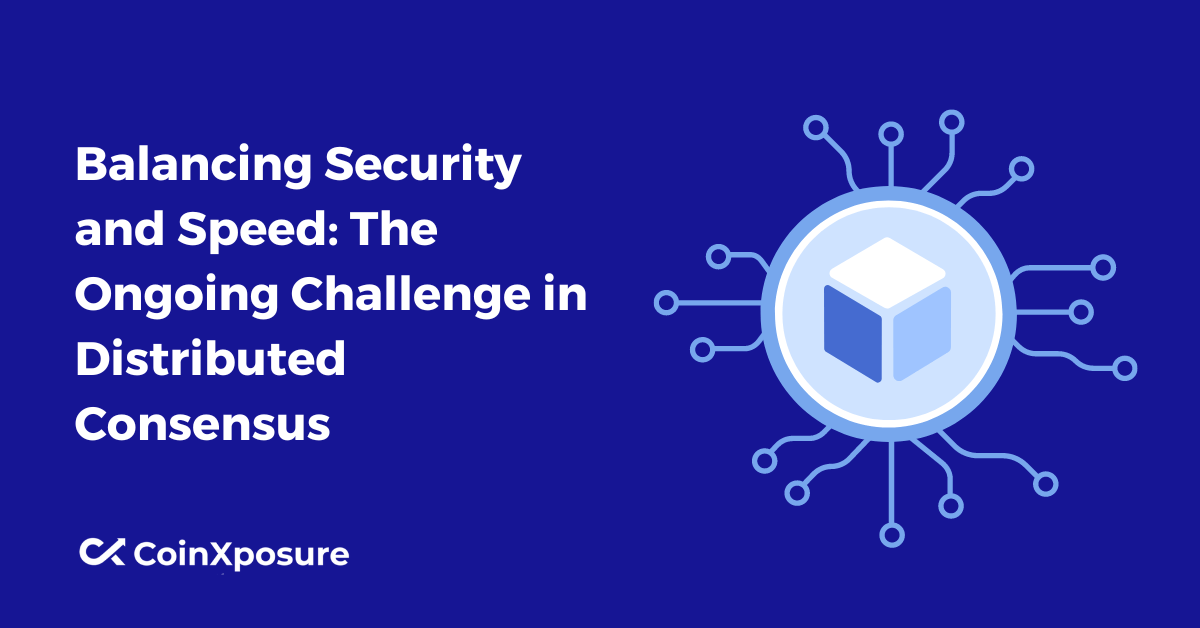
Balancing Security and Speed – The Ongoing Challenge in Distributed Consensus
In distributed systems, achieving consensus among multiple nodes is a fundamental challenge. Balancing the imperative of robust security with the necessity for swift transaction processing forms a perpetual conundrum.
This delicate equilibrium, essential for the seamless functioning of distributed systems, underlines the ongoing challenge of navigating the intricate interplay between security measures and the need for expeditious operations.
This article sets the stage for exploring the complexities of maintaining this equilibrium and the strategies employed in addressing this persistent dilemma.
The Challenge
The challenge at the core of distributed consensus lies in striking a harmonious balance between ensuring the security of transactions and achieving optimal processing speed. Inherent trade-offs between these two objectives create a dynamic landscape where enhancing one aspect often comes at the expense of the other.
The intricate nature of this challenge is magnified by the diverse and evolving threats in the digital realm, necessitating constant adaptation to safeguard against malicious activities while sustaining efficient system performance.
This delicate equilibrium forms the crux of the ongoing struggle those engineering and managing distributed consensus systems face.
Security Considerations
Security considerations in distributed consensus are paramount to safeguarding the integrity of transactions and the overall system. Byzantine Fault Tolerance (BFT) becomes a pivotal aspect, addressing the challenge of malicious nodes providing conflicting information.
Guarding against Sybil attacks, where adversaries manipulate the network by creating multiple false identities, further underscores the need for robust security measures.
Additionally, preventing double spending, a potential threat to the integrity of transactions, adds another layer of complexity in designing distributed consensus protocols. These security considerations collectively demand meticulous attention to ensure the trustworthiness of decentralized systems.
Speed Considerations
In distributed consensus, speed considerations are crucial to maintaining the efficiency and responsiveness of systems. Latency in communication between nodes introduces challenges, as delays can impede the timely agreement on transactions.
Scalability becomes a pivotal concern, as the system’s ability to handle a growing number of transactions without compromising speed is essential.
Balancing these considerations is intricate, requiring careful optimization of communication protocols and resource allocation to ensure that distributed systems operate swiftly while upholding the integrity of the consensus process.
YouApproaches to Balancing
To address the intricate challenge of balancing security and speed in distributed consensus, various approaches have emerged:
- Hybrid Consensus Mechanisms
- Optimizing Communication Protocols
- Dynamic Adjustments Based on Network Conditions
Hybrid Consensus Mechanisms
- Combining elements of different consensus algorithms to leverage the strengths of each.
- Example: Byzantine Fault Tolerance (BFT) for security and Proof of Stake (PoS) for speed.
Optimizing Communication Protocols
- Enhancing the efficiency of communication channels between nodes to minimize latency.
- Prioritizing streamlined message propagation for faster consensus.
Dynamic Adjustments Based on Network Conditions
- Implementing adaptive protocols that dynamically adjust parameters based on real-time network conditions.
- Enabling the system to respond to changing security threats and fluctuations in transaction volumes.
These approaches highlight the innovative strategies employed to balance the imperative of robust security and the demand for expeditious transaction processing in distributed consensus systems.
Future Trends of Distributed Consensus
Looking ahead, several trends are expected to shape the landscape of balancing security and speed in distributed consensus:
- Innovations in Consensus Algorithms
- Integration of AI for Dynamic Decision-making
- Advancements in Blockchain Networks
Innovations in Consensus Algorithms
- Continued development of novel consensus algorithms addressing both security and speed concerns.
- Exploration of consensus mechanisms that offer enhanced performance without compromising on resilience.
Integration of AI for Dynamic Decision-making
- Utilizing artificial intelligence to analyze network conditions and make real-time adjustments.
- Implementing machine learning for adaptive security measures and optimized transaction processing.
Advancements in Blockchain Networks
- Evolution of blockchain technologies with improved scalability and consensus mechanisms.
- Integration of layer 2 solutions to enhance transaction throughput without compromising decentralization.
These future trends underscore a trajectory towards more sophisticated, adaptive, and efficient distributed consensus systems that can adeptly navigate the ongoing challenge of balancing security and speed.
Conclusion
The ongoing challenge of balancing security and speed in distributed consensus systems represents a dynamic and intricate endeavor.
As the digital landscape evolves, the imperative to fortify systems against malicious threats while maintaining swift transaction processing becomes increasingly complex. Innovations in hybrid consensus mechanisms, optimized communication protocols, and dynamic adjustments based on network conditions exemplify the continual efforts to strike an equilibrium.
Looking forward, the future trends suggest a path of continuous evolution, marked by innovations in consensus algorithms, the integration of artificial intelligence for dynamic decision-making, and advancements in blockchain networks.
This trajectory underscores the commitment to finding resilient and efficient solutions that address the nuanced interplay between security and speed in distributed consensus.
As research and development progress, a harmonious coexistence of robust security and expeditious operations will remain at the forefront of endeavors to shape the future of decentralized systems.
